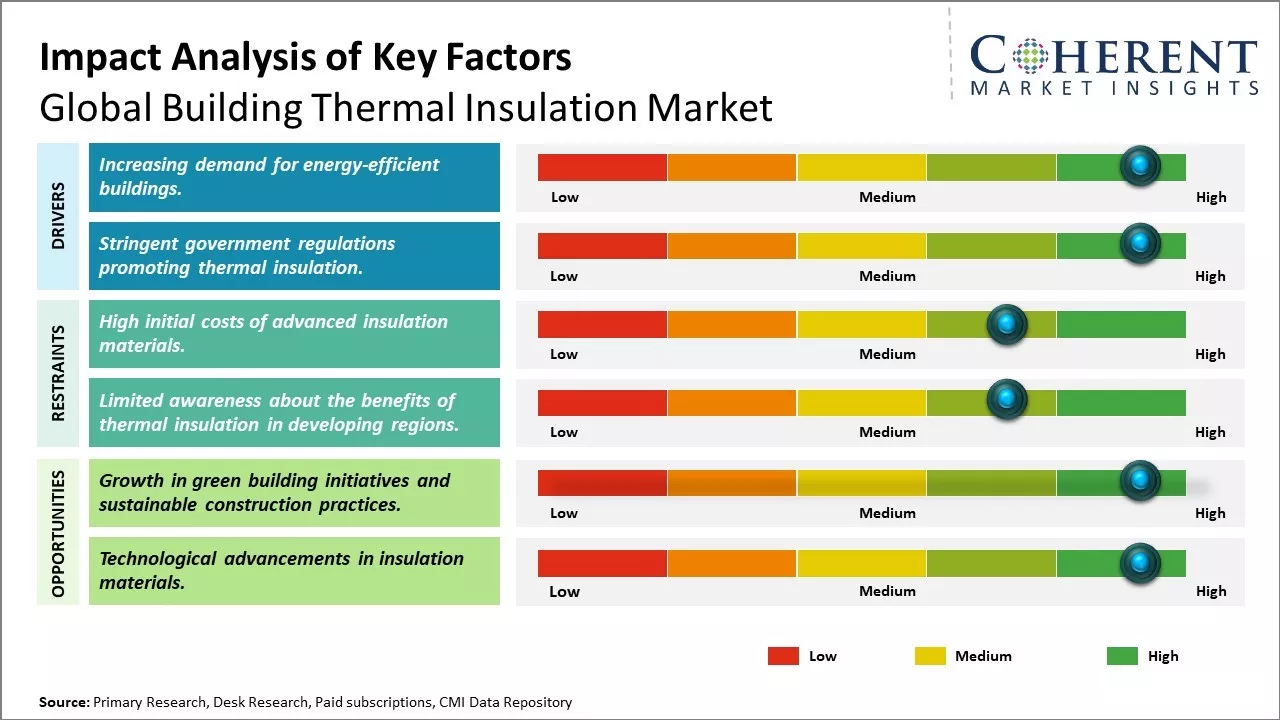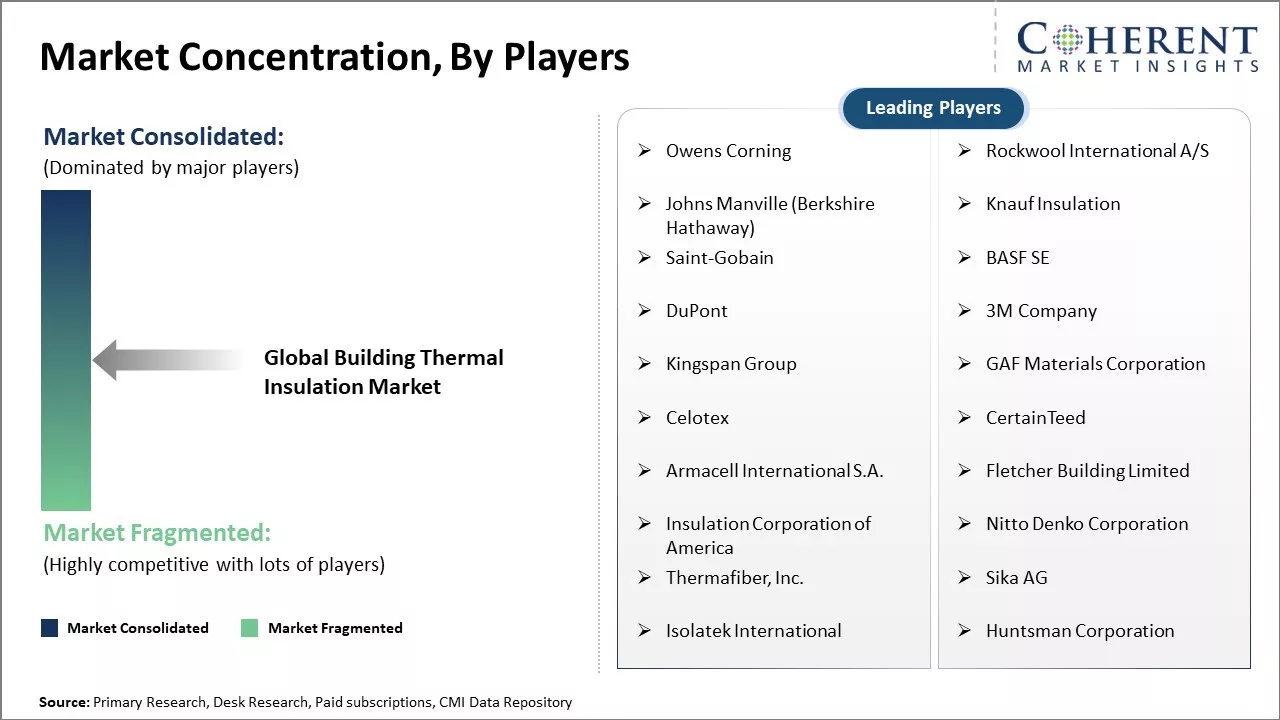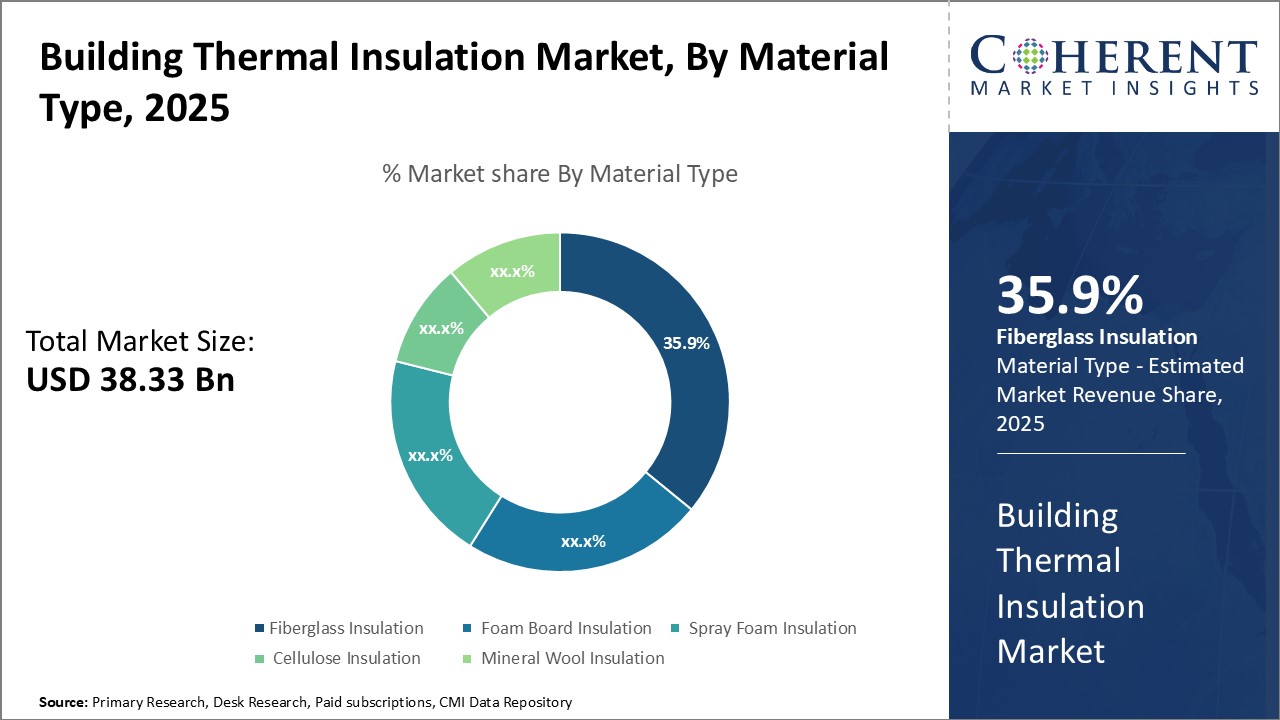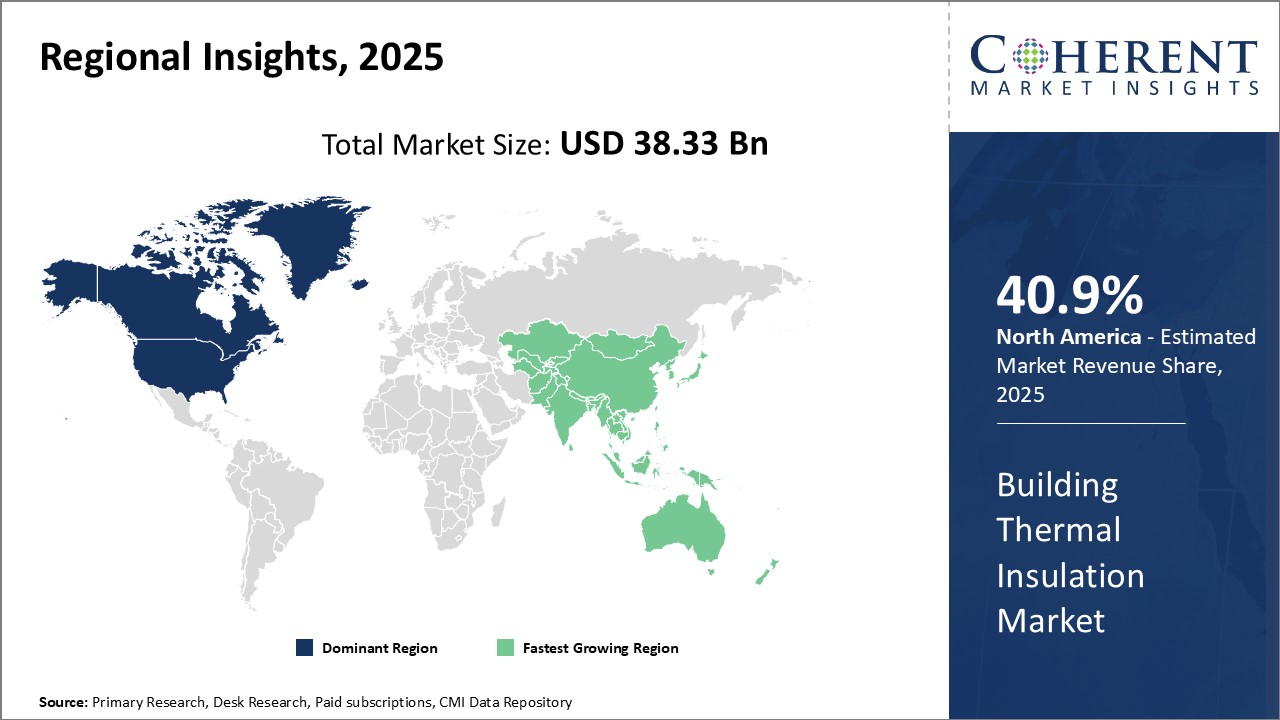Building Thermal Insulation Market Size and Trends
Global building thermal insulation market is estimated to be valued at USD 38.33 Bn in 2025 and is expected to reach USD 52.20 Bn by 2032, exhibiting a compound annual growth rate (CAGR) of 4.5% from 2025 to 2032.

Discover market dynamics shaping the industry: Download Free Sample
Increased investments in energy-efficient building construction driven by stringent government regulations regarding greenhouse gas emissions will boost the demand for building thermal insulation materials. Rising population and rapid urbanization in developing countries India and China and other, also creating demand for residential and commercial buildings which require thermal insulation for efficient temperature regulation and conservation of energy, according to data from Worldometers in 2025, the global population is growing at an approximate rate of 0.91% per year. This growth rate translates to an annual increase of about 73 million people. This steady rise in population highlights the ongoing demographic changes and the need for effective planning in areas such as resource management, infrastructure, healthcare, and food security to accommodate the growing number of individuals worldwide.
Increasing demand for energy-efficient buildings
With growing concerns about climate change and rising energy costs, building owners and contractors are increasingly looking at ways to make their structures more energy efficient. One of the most effective methods is improving a building's thermal insulation. Proper insulation not only reduces energy consumption needed for heating and cooling but also enhances indoor climate control and occupant comfort.
Several factors are fueling greater interest in well-insulated buildings. Population growth and urbanization trends have led to more construction of residential and commercial real estate which needs to be built sustainably. Rising utility bills are also motivating building owners to adopt insulation solutions that can significantly lower their long-term energy expenditures. Additionally, an environmentally conscious younger generation is driving demand for green buildings that minimize their carbon footprint. Some real estate developers have also recognized energy efficiency as a valuable marketing point to attract tenants and buyers who are willing to pay a premium for properties with lower operating costs.
The real estate sector is responding to these market dynamics. More construction projects now specify rigorous insulation standards to earn certification under programs like Leadership in Energy and Environmental Design (LEED). Walls, attics, and other structures are being fortified with high-performance insulation materials like fiberglass, mineral wool, and spray foam which provide superior R-values. Double or triple pane Energy Star rated windows with insulating frames are also increasingly specified. Real estate owners with existing buildings are undertaking retrofit projects like attic upgrades and boiler replacements or turning to incentives for energy audits that recommend customized insulation upgrades. The uptick in insulation retrofits is expected to remain strong as the push for carbon neutrality rises.
Market Concentration and Competitive Landscape

Get actionable strategies to beat competition: Download Free Sample
Stringent government regulations promoting thermal insulation
With the dangers of climate change becoming ever clearer, governments worldwide are taking aggressive steps to curb greenhouse gas emissions from the building sector. As buildings account for around 40% of energy use in many countries, policies aimed at making structures more energy efficient can significantly reduce overall carbon footprint. Thermal insulation plays a crucial role in these efforts as a cost-effective way to slash energy consumption from heating and cooling.
In developed markets, regulations have tightened considerably in recent years. For example, the European Union now mandates near-zero energy building codes for all new constructions from 2021 onward. Individual nations have matched this ambition with roadmaps for major efficiency upgrades to existing housing as well. North America too is enhancing building codes through collaborative initiatives like the International Energy Conservation Code. Emerging economies are catching up as well—China, India, Brazil have implemented insulation benchmarking into their construction standards to channel stimulus towards a greener sector.
Compliance is monitored closely and penalties levied on defaulters. Simultaneously, governments dangle attractive rebates and tax breaks for builders achieving ultra-high insulation levels. Some directly fund insulation projects through dedicated schemes. This policy push has created a stable demand pipeline, encouraged product innovation and boosted manufacturer confidence. The thermal insulation industry is well positioned to support the decarbonization goals of nations by delivering solutions fulfilling both regulatory obligations and voluntary net-zero ambitions of the real estate industry. The regulatory drive ensures the market remains buoyant over the long run.
Key Takeaways from Analyst:
Global building thermal insulation market is poised to grow driven by stringent energy efficiency regulations across major economies. North America currently dominate market share due to their early adoption of strict codes and standards. However, growth in developing regions such as Asia Pacific and the Middle East is expected to outpace total market expansion.
Government initiatives promoting green construction through tax rebates and subsidies also provide opportunities for insulation vendors. In addition, higher consumer awareness about long-term savings on energy bills is prompting more builders and homeowners to opt for well-insulated structures. Rising disposable incomes could further spur insulation installation in residential real estate across emerging markets. However, high material costs may restrain the market to some extent, especially in price-sensitive developing countries.
Product and process innovation will be critical for manufacturers to sustain growth momentum. The market is witnessing a shift toward more sustainable insulation materials made from recycled or bio-based content. Adoption of advanced techniques like vacuum insulation panel systems could also accelerate to meet stringent requirements. While regulatory compliance will remain a key driver, energy-efficiency goals of countries may raise the bar for building insulation standards in the coming years. This could open up new profit pools for market players.
Market Challenge - High initial costs of advanced insulation materials.
Global building thermal insulation market faces significant challenges due to the high initial costs of advanced insulation materials. While materials like aerogel and vacuum insulated panels provide unparalleled thermal insulation properties and help reduce long term energy costs, their initial prices are much higher than traditional insulation options like fiberglass and foam. For builders and construction companies, the substantially higher upfront expenditure poses serious budgeting issues. Additionally, the lack of awareness among common homeowners regarding life-cycle cost savings also limits the demand for premium products. To drive wider adoption, manufacturers must focus on bringing down prices through economies of scale and innovations. Subsidization support from governments can encourage greener choices. However, various nations have differing policy priorities and budgetary allowances, restricting the viability of such incentives. Overall, overcoming the perception of high costs remains a major roadblock in proliferating next-gen insulation technologies.
Market Opportunity - Growth in green building initiatives and sustainable construction practices
Global building thermal insulation market is presented with significant opportunities owing to the rapid growth in green building initiatives and sustainable construction practices. With rising environmental consciousness, many countries have formulated stringent regulations mandating minimum energy efficiency standards for new buildings. This has majorly driven the replacement demand for existing insulation with better performing products. Additionally, various programs promoting Leadership in Energy and Environmental Design (LEED) certification have elevated the focus on thermal performance of buildings. Major architects and real estate developers are also recognizing energy efficiency as a key competitive differentiator and are willing to invest in premium insulation options. This presents lucrative prospects for manufacturers of advanced materials with superior insulation values like aerogel, vacuum insulated panels, and phase change materials. Furthermore, incentives offered by governments through tax credits and subsides for green buildings are encouraging wider adoption of efficient insulation solutions.

Discover high revenue pocket segments and roadmap to it: Download Free Sample
Insights by material type: Factors Influencing the Preference for Fiberglass Insulation Materials
The fiberglass insulation segment is estimated to contribute the highest market share of 35.9% of the global building thermal insulation market in 2025, owing to its versatility and balanced performance characteristics. Fiberglass insulation is made from molten glass spun into very fine fibers and produced as mats for cutting and fitting between wall studs or attic joists. It provides good thermal resistance and aids in managing both heat and cold, keeping indoor spaces comfortable year-round.
A key factor driving continued demand is fiberglass' moisture resistance. While other common insulation materials like cellulose or fiber can degrade over time if they absorb moisture, fiberglass insulation is not impacted by minor moisture infiltration. This makes it ideal for below-grade applications like basements as well as humid coastal regions. Fiberglass insulation also does not mold, mildew or rot, retaining its R-value even under wet conditions.
Its fire resistance is another advantage. Fiberglass wool is non-combustible and acts as a barrier to the spread of fire. This fireproof quality is important for meeting building code requirements and assuring safety. Fiberglass insulation also has the benefit of being chemically inert with no off-gassing of volatile organic compounds (VOCs), making it a healthier option for indoor air quality.
In addition, fiberglass insulation is durable and lasts the lifetime of the building without settling or losing effectiveness if properly installed. It is also dimensionally stable, retaining its shape for a neat, snug fit. Maintenance is simple with no need for re-fluffing or reinstallation over time. Overall, fiberglass' balanced performance, ease of use and resilience have led to it becoming the material of choice for insulation needs across residential, commercial and industrial sectors worldwide, therefore growing launch of new products by key players is expected to drive the segment growth, In May 2024, Knauf Insulation, Inc., a leading family-owned manufacturer of fiberglass insulation, launched its new HVAC fiberglass insulation product line, Knauf Performance+. This innovative line is the first to be CERTIFIED asthma & allergy friendly and is completely formaldehyde-free, making it an excellent choice for improving indoor air quality and appealing to health-conscious consumers and builders.
Insights by application: Residential Buildings: Largest End User Market Segment
The residential buildings segment accounts for the largest demand in the global building thermal insulation market, projected to hold a 38.3% share in 2025. This is primarily due to the vast number of housing units worldwide that require insulation for energy efficiency and comfort. Individual homes represent a greater consumption of insulation materials compared to other building types, as there are simply more houses than any other type of structure.
Homeowners' motivation to save on monthly heating and cooling bills also makes insulation an attractive upgrade for residential energy management. As awareness of environmental protection and carbon footprint reduction increases, occupants see thermal insulation as an effective solution. Additional benefits like improved indoor air quality, moisture control and noise reduction further incentivize residential insulation installation.
Government regulations and building codes in many countries now mandate minimum insulation standards for new housing to ensure compliance with sustainability goals. Financial incentives like tax credits in some regions also subsidize residential energy efficiency projects including attic, wall and basement insulation. With the link between insulation, energy savings and cost of living expenses clearly established, demand is expected to remain steady from the residential sector.
Regional Insights

Need a Different Region or Segment? Download Free Sample
North America has dominated the global building thermal insulation market for years with an estimated 40.9% share in 2025, owing to the well-established residential and commercial construction sectors in major economies like the U.S. Strict regulations regarding energy efficiency in buildings across many states drive the demand for high performing insulation materials in both retrofits and new construction. Leading insulation manufacturers have concentrated their production capacities and innovation efforts in this region to cater to the large and influential customer base.
While the market has matured in North America, Asia Pacific has emerged as the fastest growing regional market. Rapid urbanization and industrialization are fueling massive infrastructure growth across developing countries like China and India. Both nations are witnessing unprecedented rates of new commercial and residential real estate development. This spurt in construction activities has boosted the uptake of thermal insulation to meet sustainability targets and cut energy bills over the lifetime of buildings.
Affordability becomes a key factor for insulation choice in Asia Pacific's price sensitive markets compared to North America. Hence, the availability of low-cost insulation options such as glass wool and stone wool has boosted their popularity versus more premium products like Expanded Polystyrene (EPS) and Extruded Polystyrene (XPS). Local manufacturers are enhancing production volumes to benefit from strong domestic demand while also eyeing opportunities in regional export hubs.
Multinational corporates see immense scope to tap into Asia Pacific's expanding insulation market through strategic investments, partnerships and capacity expansions alongside their local peers. From Singapore to Shanghai, many have set up or are planning state-of-the-art manufacturing facilities with integrated research wings to develop customized products tailored to codes and climatic conditions across the diverse region.
Market Report Scope
Building Thermal Insulation Market Report Coverage
| Report Coverage | Details | ||
|---|---|---|---|
| Base Year: | 2024 | Market Size in 2025: | USD 38.33 Bn |
| Historical Data for: | 2020 To 2024 | Forecast Period: | 2025 To 2032 |
| Forecast Period 2025 to 2032 CAGR: | 4.5% | 2032 Value Projection: | USD 52.20 Bn |
| Geographies covered: |
|
||
| Segments covered: |
|
||
| Companies covered: |
Owens Corning, Rockwool International A/S, Johns Manville (Berkshire Hathaway), Knauf Insulation, Saint-Gobain, BASF SE, DuPont, 3M Company, Kingspan Group, GAF Materials Corporation, Celotex, CertainTeed, Armacell International S.A., Fletcher Building Limited, Insulation Corporation of America, Nitto Denko Corporation, Thermafiber, Inc., Sika AG, Isolatek International, and Huntsman Corporation |
||
| Growth Drivers: |
|
||
| Restraints & Challenges: |
|
||
Uncover macros and micros vetted on 75+ parameters: Get instant access to report
Market Segmentation
- By Material Type Insights (Revenue, USD Bn, 2020 - 2032)
-
- Fiberglass Insulation
- Foam Board Insulation
- Spray Foam Insulation
- Cellulose Insulation
- Mineral Wool Insulation
- By Application Insights (Revenue, USD Bn, 2020 - 2032)
-
- Residential Buildings
- Commercial Buildings
- Industrial Buildings
- Regional Insights (Revenue, USD Bn, 2020 - 2032)
- North America
- U.S.
- Canada
- Latin America
- Brazil
- Argentina
- Mexico
- Rest of Latin America
- Europe
- Germany
- U.K.
- Spain
- France
- Italy
- Russia
- Rest of Europe
- Asia Pacific
- China
- India
- Japan
- Australia
- South Korea
- ASEAN
- Rest of Asia Pacific
- Middle East
- GCC Countries
- Israel
- Rest of Middle East
- Africa
- South Africa
- North Africa
- Central Africa
- North America
- Key Players Insights
-
- Owens Corning
- Rockwool International A/S
- Johns Manville (Berkshire Hathaway)
- Knauf Insulation
- Saint-Gobain
- BASF SE
- DuPont
- 3M Company
- Kingspan Group
- GAF Materials Corporation
- Celotex
- CertainTeed
- Armacell International S.A.
- Fletcher Building Limited
- Insulation Corporation of America
- Nitto Denko Corporation
- Thermafiber, Inc.
- Sika AG
- Isolatek International
- Huntsman Corporation
Share
Share
About Author
Yash Doshi is a Senior Management Consultant. He has 12+ years of experience in conducting research and handling consulting projects across verticals in APAC, EMEA, and the Americas.
He brings strong acumen in helping chemical companies navigate complex challenges and identify growth opportunities. He has deep expertise across the chemicals value chain, including commodity, specialty and fine chemicals, plastics and polymers, and petrochemicals. Yash is a sought-after speaker at industry conferences and contributes to various publications on topics related commodity, specialty and fine chemicals, plastics and polymers, and petrochemicals.
Missing comfort of reading report in your local language? Find your preferred language :
Transform your Strategy with Exclusive Trending Reports :
Frequently Asked Questions
EXISTING CLIENTELE
Joining thousands of companies around the world committed to making the Excellent Business Solutions.
View All Our Clients
